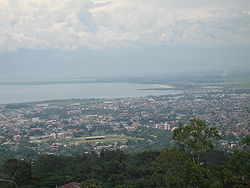Bujumbura
Bujumbura is the former capital city of Burundi. The city is at the northeastern corner of Lake Tanganyika. It is the largest city in the country. The city is the administrative, communications, and economic center of Burundi. Bujumbura has a population of about 324,000 people. The city makes textiles, soap and other things. Bujumbura is Burundi's main port. It transports most of the country's main export, coffee, as well as cotton, animal skins, and tin ore.
 | |
| Coordinates: 3°23′S 29°22′E / 3.383°S 29.367°ECoordinates: 3°23′S 29°22′E / 3.383°S 29.367°E | |
| Country | |
| Province | Bujumbura Mairie Province |
| Founded | 1871 |
| Government | |
| • Mayor | Freddy Mbonimpa |
| Area | |
| • City | 127 km2 (49 sq mi) |
| Elevation | 774 m (2,539 ft) |
| Population (2019 census) | |
| • City | 1,092,859 |
| • Density | 8,506/km2 (22,030/sq mi) |
| • Urban | 1,500,000 |
| Time zone | UTC+2 (CAT) |
| Climate | Aw |
| Website | www |
The city center is a colonial town. It has a large market, the national stadium, a large mosque, and a cathedral. Museums in the city include the Burundi Museum of Life and the Burundi Geological Museum. Other things to see include the Rusizi National Park.
Ferries sail from Bujumbura to Kigoma in Tanzania. The city is also home to the Bujumbura International Airport and the University of Bujumbura.
History
Bujumbura grew from a small village after it became a military post in German East Africa in 1889 . After World War I, it was made the administrative center of the Belgian controlled Ruanda-Urundi. The city's name was changed from Usumbura to Bujumbura when Burundi became independent in 1962 . Since independence, Bujumbura has been the scene of much fighting between the country's two main ethnic groups, with Hutu militias fighting against the Burundi army which has many Tutsi people in it.
Bujumbura Media
Other websites
| Wikimedia Commons has media related to Lua error in Module:Commons_link at line 62: attempt to index field 'wikibase' (a nil value).. |
- Map of Bujumbura at fallingrain.com







